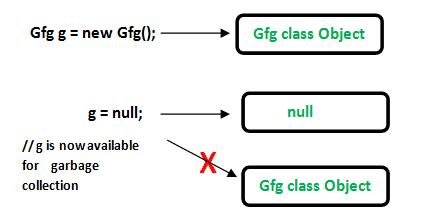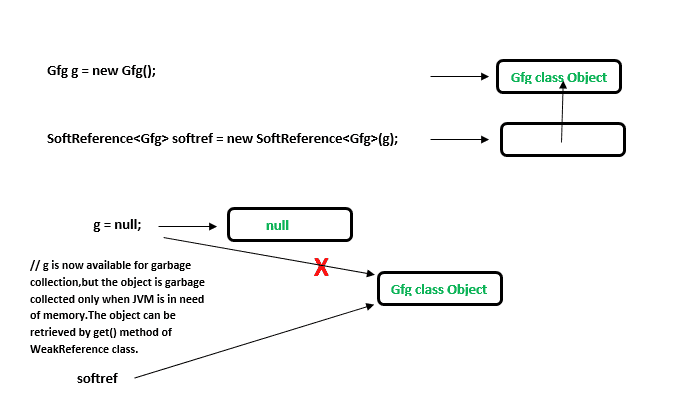在Java中,有四种类型的引用根据垃圾收集的方式进行区分。
null
- 有力的证明
- 弱引用
- 软引用
- 幻影参考
先决条件: 垃圾收集
- 强有力的参考: 这是引用对象的默认类型/类别。任何具有活动强引用的对象都不符合垃圾收集的条件。仅当强引用的变量指向null时,才会对对象进行垃圾收集。
MyClass obj = new MyClass ();
这里的“obj”对象是对新创建的MyClass实例的强引用,目前obj是活动对象,所以不能被垃圾收集。
obj = null; //'obj' object is no longer referencing to the instance. So the 'MyClass type object is now available for garbage collection.

// Java program to illustrate Strong referenceclassGfg{//Code..}publicclassExample{publicstaticvoidmain(String[] args){//Strong Reference - by defaultGfg g =newGfg();//Now, object to which 'g' was pointing earlier is//eligible for garbage collection.g =null;}} - 弱引用: 弱引用对象不是引用对象的默认类型/类,在使用它们时应该显式指定它们。
- 这种类型的引用在WeakHashMap中用于引用条目对象。
- 如果JVM检测到一个对象只有弱引用(即没有链接到任何对象的强引用或软引用),该对象将被标记为垃圾收集。
- 创建这样的引用 JAVAlang.ref.WeakReference 使用类。
- 这些引用在实时应用程序中使用,同时建立DBConnection,当使用数据库的应用程序关闭时,垃圾收集器可能会清除DBConnection。

//Java Code to illustrate Weak referenceimportjava.lang.ref.WeakReference;classGfg{//codepublicvoidx(){System.out.println("GeeksforGeeks");}}publicclassExample{publicstaticvoidmain(String[] args){// Strong ReferenceGfg g =newGfg();g.x();// Creating Weak Reference to Gfg-type object to which 'g'// is also pointing.WeakReference<Gfg> weakref =newWeakReference<Gfg>(g);//Now, Gfg-type object to which 'g' was pointing earlier//is available for garbage collection.//But, it will be garbage collected only when JVM needs memory.g =null;// You can retrieve back the object which// has been weakly referenced.// It successfully calls the method.g = weakref.get();g.x();}}输出:
GeeksforGeeks GeeksforGeeks
有两种不同程度的软弱:软弱和虚幻
- 软参考: 在软引用中,即使对象可以进行垃圾收集,也不会进行垃圾收集,直到JVM严重需要内存。当JVM耗尽内存时,对象将从内存中清除。创建这样的引用 JAVAlang.ref.SoftReference 使用类。

//Code to illustrate Soft referenceimportjava.lang.ref.SoftReference;classGfg{//code..publicvoidx(){System.out.println("GeeksforGeeks");}}publicclassExample{publicstaticvoidmain(String[] args){// Strong ReferenceGfg g =newGfg();g.x();// Creating Soft Reference to Gfg-type object to which 'g'// is also pointing.SoftReference<Gfg> softref =newSoftReference<Gfg>(g);// Now, Gfg-type object to which 'g' was pointing// earlier is available for garbage collection.g =null;// You can retrieve back the object which// has been weakly referenced.// It successfully calls the method.g = softref.get();g.x();}}输出:
GeeksforGeeks GeeksforGeeks
- 幻影参考: 虚引用引用的对象符合垃圾收集的条件。但是,在从内存中删除它们之前,JVM会将它们放入一个名为“引用队列”的队列中。在对它们调用finalize()方法后,它们被放入引用队列。创建这样的引用 JAVAlang.ref.PhantomReference 使用类。
//Code to illustrate Phantom referenceimportjava.lang.ref.*;classGfg{//codepublicvoidx(){System.out.println("GeeksforGeeks");}}publicclassExample{publicstaticvoidmain(String[] args){//Strong ReferenceGfg g =newGfg();g.x();//Creating reference queueReferenceQueue<Gfg> refQueue =newReferenceQueue<Gfg>();//Creating Phantom Reference to Gfg-type object to which 'g'//is also pointing.PhantomReference<Gfg> phantomRef =null;phantomRef =newPhantomReference<Gfg>(g,refQueue);//Now, Gfg-type object to which 'g' was pointing//earlier is available for garbage collection.//But, this object is kept in 'refQueue' before//removing it from the memory.g =null;//It always returns null.g = phantomRef.get();//It shows NullPointerException.g.x();}}运行时错误:
Exception in thread "main" java.lang.NullPointerException at Example.main(Example.java:31)输出:
GeeksforGeeks
本文由 普拉蒂克·阿加瓦尔 .如果你喜欢GeekSforgek,并想贡献自己的力量,你也可以使用 贡献极客。组织 或者把你的文章寄到contribute@geeksforgeeks.org.看到你的文章出现在Geeksforgeks主页上,并帮助其他极客。
如果您发现任何不正确的地方,或者您想分享有关上述主题的更多信息,请写下评论。
© 版权声明
文章版权归作者所有,未经允许请勿转载。
THE END


![关于”PostgreSQL错误:关系[表]不存在“问题的原因和解决方案-yiteyi-C++库](https://www.yiteyi.com/wp-content/themes/zibll/img/thumbnail.svg)






